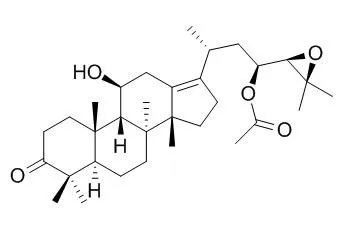| Kinase Assay: |
| Toxicol Appl Pharmacol. 2015 Mar 15;283(3):178-86. | | Alisol B 23-acetate protects against ANIT-induced hepatotoxity and cholestasis, due to FXR-mediated regulation of transporters and enzymes involved in bile acid homeostasis.[Pubmed: 25655198] | Intrahepatic cholestasis is a clinical syndrome with systemic and intrahepatic accumulation of excessive toxic bile acids that ultimately cause hepatobiliary injury. Appropriate regulation of bile acids in hepatocytes is critically important for protection against liver injury.
METHODS AND RESULTS:
In the present study, we characterized the protective effect of Alisol B 23-acetate (AB23A), a natural triterpenoid, on alpha-naphthylisothiocyanate (ANIT)-induced liver injury and intrahepatic cholestasis in mice and further elucidated the mechanisms in vivo and in vitro. AB23A treatment dose-dependently protected against liver injury induced by ANIT through reducing hepatic uptake and increasing efflux of bile acid via down-regulation of hepatic uptake transporters (Ntcp) and up-regulation of efflux transporter (Bsep, Mrp2 and Mdr2) expression. Furthermore, AB23A reduced bile acid synthesis through repressing Cyp7a1 and Cyp8b1, increased bile acid conjugation through inducing Bal, Baat and bile acid metabolism through an induction in gene expression of Sult2a1. We further demonstrate the involvement of farnesoid X receptor (FXR) in the hepatoprotective effect of AB23A. The changes in transporters and enzymes, as well as ameliorative liver histology in AB23A-treated mice were abrogated by FXR antagonist guggulsterone in vivo. In vitro evidences also directly demonstrated the effect of AB23A on FXR activation in a dose-dependent manner using luciferase reporter assay in HepG2 cells.
CONCLUSIONS:
In conclusion, AB23A produces protective effect against ANIT-induced hepatotoxity and cholestasis, due to FXR-mediated regulation of transporters and enzymes. |
|
| Cell Research: |
| Phytomedicine. 2016 Jul 15;23(8):800-9. | | Effects of alisol B 23-acetate on ovarian cancer cells: G1 phase cell cycle arrest, apoptosis, migration and invasion inhibition.[Pubmed: 27288915] | Ovarian cancer is the first leading cause of death among gynecologic malignancies worldwide. Discovery of new chemotherapeutic drugs is still imperative for the improvement of the survival rate.
This study aims to investigate the anti-cancer potential of Alisol B 23-acetate (AB23), a protostane-type triterpene isolated from the Alismatis Rhizoma, in the parental and paclitaxel-resistant ovarian cancer cells.
METHODS AND RESULTS:
MTT assay was performed to evaluate cell viability after treatment with AB23, along with flow cytometry for apoptosis and cell cycle analysis. Western blotting was conducted to determine the relative protein level. Wound healing and transwell assays were performed to investigate the effect of AB23 on cell migration and invasion.
AB23 obviously inhibited proliferation of the three ovarian cancer cell lines, down-regulated the protein levels of CDK4, CDK6, and cyclin D1, and blocked the cell cycle progressions in G1 phase. Meanwhile, AB23 induced accumulation of the sub-G1 phase in the three cell lines in a concentration dependent manner. The protein levels of cleaved poly ADP-ribose polymerase (PARP) and the ratio of Bax/Bcl-2 were up-regulated after treatment with AB23. Further study showed that AB23 induced endoplasmic reticulum stress through IRE1 signaling pathway and silencing of IRE1α partially enhanced AB23-induced apoptosis. Wound healing and transwell assays showed that AB23 could also suppress the migration and invasion of HEY cells. Moreover, it down-regulated the protein levels of matrix metalloproteinases MMP-2 and MMP-9.
CONCLUSIONS:
AB23 possessed anti-proliferation, anti-migration and anti-invasion activities as a single agent on ovarian cancer cells. |
|
| Structure Identification: |
| Arch Pharm Res. 2002 Oct;25(5):608-12. | | Chemical modification of alisol B 23-acetate and their cytotoxic activity.[Pubmed: 12433190] | The twelve-protostane analogues were synthesized from Alisol B 23-acetate and assessed for their in vitro antitumor activity against six different human and murine tumor cell lines.
METHODS AND RESULTS:
Of the compounds synthesized, 23S-acetoxy-24R(25)-epoxy-11beta,23S-dihydroxyprotost-13(17)-en-3-hydroxyimine (12) exhibited significant cytotoxic activities against A549, SK-OV3, B16-F10, and HT1080 tumor cells with ED50 values of 10.0, 8.7, 5.2, and 3.1 microg/ml, respectively. Furthermore, 23S-acetoxy-13(17),24R(25)-diepoxy-11beta-hydroxyprotost-3-one (5), 13(17),24R(25)-diepoxy-11beta,23S-dihydroxyprotostan-3-one (6), 24R,25-epoxy-11beta,23S-dihydroxyprotost-13(17)-en-3-one (7), and 11beta,23S,24R,25-tetrahydroxyprotost-13(17)-en-3-one (9) showed moderate cytotoxic activities against B16-F10 and HT1080 tumor cells.
CONCLUSIONS:
These results mean that a hydroxyimino group at C-3 position in the protostane-type terpene enhances cytotoxic activity. |
|






 Cell. 2018 Jan 11;172(1-2):249-261.e12. doi: 10.1016/j.cell.2017.12.019.IF=36.216(2019)
Cell. 2018 Jan 11;172(1-2):249-261.e12. doi: 10.1016/j.cell.2017.12.019.IF=36.216(2019) Cell Metab. 2020 Mar 3;31(3):534-548.e5. doi: 10.1016/j.cmet.2020.01.002.IF=22.415(2019)
Cell Metab. 2020 Mar 3;31(3):534-548.e5. doi: 10.1016/j.cmet.2020.01.002.IF=22.415(2019) Mol Cell. 2017 Nov 16;68(4):673-685.e6. doi: 10.1016/j.molcel.2017.10.022.IF=14.548(2019)
Mol Cell. 2017 Nov 16;68(4):673-685.e6. doi: 10.1016/j.molcel.2017.10.022.IF=14.548(2019)